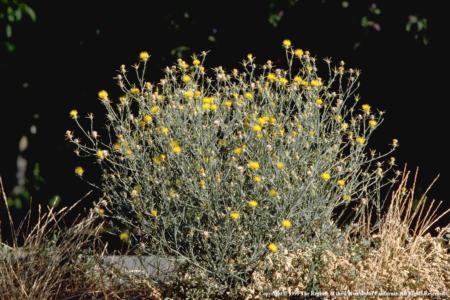
Posts Tagged: DiTomaso
Ranchers concerned about invasion of medusahead weed on foothill rangeland

Medusahead, an unwelcome transplant from Europe, is anathema to the cattle living off rangeland grass. The weed's three-inch-long bristles poke and sometimes injure the animals' mouths and eyes. The weed is also low-quality forage for livestock. When medusahead takes over rangeland, it reduces the forage value by 80 percent.
When Fadzayi Mashiri, UC Cooperative Extension advisor in Mariposa, Merced and Madera counties, was appointed in 2013, she became the first natural resources and rangeland expert to hold the position since the retirement of Wain Johnson more than a decade before. She polled local ranchers to determine their most pressing problems. They said weed management, and in particular, medusahead.
Medusahead is relatively easy to identify on the range. It has distinctive stiff awns and a seed head that does not break apart as seeds mature. Patches of medusahead are obvious when spring turns into summer.
“Medusahead stays green after most of the annual grasses have dried off,” Mashiri said.
Medusahead has high silica content, making it unpalatable to cattle. The silica also protects the plant from decomposition, so a thick thatch builds up on the rangeland, suppressing more desirable species, but not the germination of the next year's medusahead seedlings.

- Corral cows on medusahead before the plant heads out or employ sheep to graze medusahead patches. It's not sheep's favorite forage either, but they will eat if left with no other option.
- Prescribed burning in late spring or early summer. However, this strategy poses air quality and liability issues.
- Apply nitrogen fertilizer to medusahead to improve palatability before it flowers, which is showing promise for controlling the weed and boosting the value of infested rangeland.
- Chemical control.
In spring 2014, Mashiri conducted a demonstration field trial in Mariposa County of medusahead control with the herbicide Milestone, which was developed by Dow AgroSciences mainly to control broadleaf weeds like yellow starthistle. The trial followed rangeland weed control research done by scientists including Joe DiTomaso, UC Cooperative Extension specialist in the Department of Plant Sciences at UC Davis. DiTamaso found that the density of medusahead in treated areas declined and concluded that Milestone prevents medusahead seedlings from thriving.
Unfortunately, Milestone treatment of large rangeland areas is expensive.
“But if the value of forage declines, the productivity of livestock is compromised,” Mashiri said. “When you look at it that way, the chemical treatment might be useful.”
California budget cuts impact yellow starthistle control

The project was funded by the state Department of Food and Agriculture as part of its weed control budget totaling $2.7 million in 2011. That money was cut from the 2011-2012 state budget cycle. Local and federal grants that kept the program going will run out next month. A $314,000 grant from the Sierra Nevada Conservancy was denied because the group failed to meet the application requirements, the article said.
These developments may give starthistle a bigger hold on California wildland. The roots of the nuisance weed grow as much as six feet deep to find moisture.
"It would be as if these areas are experiencing drought because of the amount of water it uses," said Joe DiTomaso, UC Cooperative Extension specialist in the UC Davis Department of Plant Sciences. DiTomaso is a leading expert on starthistle.
The Leading Edge Project started about a decade ago with a mapping effort to find out just how much of the state was infested with starthistle, and where it was spreading, said Wendy West, the project's coordinator and a University of California Cooperative Extension program representative based in Placerville.
"It felt like such a losing battle that we really needed to prioritize what we could do and how we could be successful," West said.
"I've personally pulled plants at 7,000 feet in Alpine County," West said. "It may not move quite as fast, but yellow star thistle is a really good example of a plant that can adapt to new locations easily."
Two UC scientists named weed science fellows

In all, nearly nearly two dozen individuals from academia, government and private industry were recognized for their outstanding contributions to the field of weed science, according to a WSSA news release distributed yesterday.
“These are true innovators who are making a significant mark on our profession through their research, teaching, publishing, outreach and development of new best practices,” said John Jachetta, the outgoing president of WSSA.
The news release detailed Al-Khatib and DiTomaso's contributions as follows:
- Kassim Al-Khatib, director of the Integrated Pest Management Program and a professor of weed science at the University of California. His specialty is weed physiology and herbicide resistance. Al-Khatib has led significant grant programs, holds two patents and has authored or co-authored nearly 350 refereed journal articles, abstracts and proceedings, extension and research publications and book chapters.
- Joseph DiTomaso, an invasive plants specialist who is director of the Weed Research and Information Center and cooperative extension specialist in the Department of Plant Sciences, University of California, Davis. He has delivered more than 750 extension presentations and has published more than 110 peer-reviewed papers and three books. He is currently president of the Western Society of Weed Science and is editor of the journal, Invasive Plant Science and Management.
